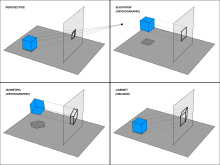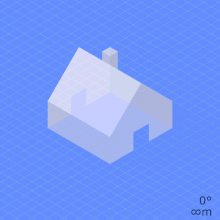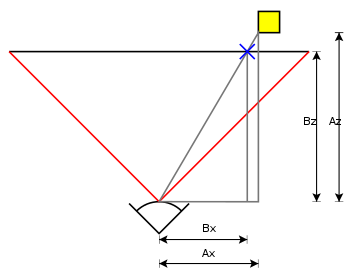3d drawing of a planar gauge

Classification of some 3D projections
A 3D projection (or graphical projection) is a pattern technique used to display a iii-dimensional (3D) object on a 2-dimensional (second) surface. These projections rely on visual perspective and aspect analysis to projection a complex object for viewing capability on a simpler plane. This concept of extending 2D geometry to 3D was mastered by Heron of Alexandria in the offset century.[1] Heron could be called the father of 3D. 3D Projection is the ground of the concept for Estimator Graphics simulating fluid flows to imitate realistic effects.[2] Lucas Films 'ILM group is credited with introducing the concept (and even the term "Particle effect").
In 1982, the start all-digital computer generated sequence for a move picture file was in: Star Trek 2: The Wrath of Khan. A 1984 patent related to this concept was written by William Due east Masters, "Computer automated manufacturing process and system" US4665492A using mass particles to fabricate a cup.[3] The process of particle deposition is ane applied science of 3D press.
3D projections employ the primary qualities of an object's basic shape to create a map of points, that are then connected to one another to create a visual element. The result is a graphic that contains conceptual properties to translate that the effigy or prototype as not really flat (second), but rather, as a solid object (3D) being viewed on a second display.
3D objects are largely displayed on two-dimensional mediums (i.e. paper and reckoner monitors). Equally such, graphical projections are a ordinarily used design element; notably, in engineering drawing, drafting, and computer graphics. Projections can exist calculated through employment of mathematical assay and formulae, or past using various geometric and optical techniques.
Overview [edit]

Several types of graphical projection compared

Various projections and how they are produced
Project is achieved by the utilise of imaginary "projectors"; the projected, mental epitome becomes the technician's vision of the desired, finished pic.[ further explanation needed ] Methods provide a uniform imaging process among people trained in technical graphics (mechanical drawing, computer aided design, etc.). Past following a method, the technician may produce the envisioned moving picture on a planar surface such as drawing newspaper.
There are two graphical projection categories, each with its own method:
- parallel projection
- perspective projection
Parallel projection [edit]

Parallel projection corresponds to a perspective projection with a hypothetical viewpoint; i.due east. one where the camera lies an infinite distance away from the object and has an infinite focal length, or "zoom".
In parallel projection, the lines of sight from the object to the projection plane are parallel to each other. Thus, lines that are parallel in 3-dimensional space remain parallel in the ii-dimensional projected epitome. Parallel projection likewise corresponds to a perspective projection with an infinite focal length (the distance from a photographic camera'southward lens and focal point), or "zoom".
Images drawn in parallel projection rely upon the technique of axonometry ("to measure along axes"), as described in Pohlke's theorem. In general, the resulting paradigm is oblique (the rays are not perpendicular to the image plane); but in special cases the result is orthographic (the rays are perpendicular to the epitome plane). Axonometry should not be dislocated with axonometric projection, equally in English literature the latter ordinarily refers only to a specific class of pictorials (see below).
Orthographic project [edit]
The orthographic projection is derived from the principles of descriptive geometry and is a two-dimensional representation of a three-dimensional object. It is a parallel projection (the lines of projection are parallel both in reality and in the project plane). It is the projection blazon of choice for working drawings.
If the normal of the viewing aeroplane (the camera direction) is parallel to one of the principal axes (which is the x, y, or z centrality), the mathematical transformation is as follows; To project the 3D indicate , , onto the 2nd point , using an orthographic projection parallel to the y axis (where positive y represents forward direction - profile view), the post-obit equations can be used:
where the vector s is an arbitrary scale factor, and c is an arbitrary starting time. These constants are optional, and tin can exist used to properly align the viewport. Using matrix multiplication, the equations become:
While orthographically projected images correspond the three dimensional nature of the object projected, they exercise non represent the object equally it would be recorded photographically or perceived by a viewer observing information technology direct. In item, parallel lengths at all points in an orthographically projected image are of the same scale regardless of whether they are far away or near to the virtual viewer. As a result, lengths are non foreshortened as they would be in a perspective projection.
Multiview projection [edit]

Symbols used to define whether a multiview project is either 3rd Bending (right) or Get-go Bending (left).
With multiview projections, up to six pictures (chosen chief views) of an object are produced, with each projection airplane parallel to one of the coordinate axes of the object. The views are positioned relative to each other according to either of two schemes: first-angle or tertiary-bending projection. In each, the appearances of views may be thought of as beingness projected onto planes that course a 6-sided box around the object. Although six different sides can be drawn, usually three views of a drawing give plenty information to brand a 3D object. These views are known as front view, height view, and end view. The terms elevation, programme and section are too used.
Oblique projection [edit]

Potting bench drawn in chiffonier project with an angle of 45° and a ratio of two/3

Stone curvation fatigued in armed services perspective
In oblique projections the parallel projection rays are not perpendicular to the viewing airplane every bit with orthographic projection, just strike the projection plane at an angle other than ninety degrees. In both orthographic and oblique projection, parallel lines in infinite appear parallel on the projected image. Considering of its simplicity, oblique projection is used exclusively for pictorial purposes rather than for formal, working drawings. In an oblique pictorial drawing, the displayed angles among the axes as well equally the foreshortening factors (scale) are arbitrary. The distortion created thereby is ordinarily attenuated by aligning ane aeroplane of the imaged object to be parallel with the plane of projection thereby creating a truthful shape, full-size epitome of the called aeroplane. Special types of oblique projections are:
Cavalier projection (45°) [edit]
In condescending projection (sometimes condescending perspective or high view indicate) a signal of the object is represented past three coordinates, x, y and z. On the drawing, it is represented by only two coordinates, x″ and y″. On the flat drawing, two axes, x and z on the figure, are perpendicular and the length on these axes are fatigued with a ane:1 calibration; it is thus similar to the dimetric projections, although it is not an axonometric projection, as the 3rd axis, here y, is drawn in diagonal, making an arbitrary angle with the x″ centrality, unremarkably 30 or 45°. The length of the third axis is not scaled.
Cabinet project [edit]
The term cabinet projection (sometimes cabinet perspective) stems from its use in illustrations by the article of furniture industry.[ citation needed ] Like cavalier perspective, one face of the projected object is parallel to the viewing plane, and the tertiary axis is projected as going off in an angle (typically thirty° or 45° or arctan(2) = 63.4°). Unlike condescending project, where the third axis keeps its length, with cabinet projection the length of the receding lines is cut in half.
Military project [edit]
A variant of oblique projection is called military machine projection. In this instance, the horizontal sections are isometrically fatigued so that the floor plans are not distorted and the verticals are drawn at an angle. The military project is given by rotation in the xy-plane and a vertical translation an corporeality z.[4]
Axonometric projection [edit]

Axonometric projections show an image of an object as viewed from a skew direction in order to reveal all 3 directions (axes) of infinite in ane picture show.[v] Axonometric projections may exist either orthographic or oblique. Axonometric musical instrument drawings are oftentimes used to approximate graphical perspective projections, only in that location is attendant distortion in the approximation. Because pictorial projections innately contain this distortion, in musical instrument drawings of pictorials slap-up liberties may then be taken for economic system of try and all-time upshot.[ clarification needed ]
Axonometric projection is further subdivided into 3 categories: isometric projection, dimetric project, and trimetric projection, depending on the exact angle at which the view deviates from the orthogonal.[6] [7] A typical characteristic of orthographic pictorials is that ane axis of space is ordinarily displayed equally vertical.
Axonometric projections are also sometimes known equally auxiliary views, as opposed to the primary views of multiview projections.
Isometric projection [edit]
In isometric pictorials (for methods, see Isometric project), the management of viewing is such that the three axes of infinite appear equally foreshortened, and there is a mutual angle of 120° between them. The distortion caused past foreshortening is compatible, therefore the proportionality of all sides and lengths are preserved, and the axes share a common scale. This enables measurements to be read or taken directly from the drawing.
Dimetric projection [edit]
In dimetric pictorials (for methods, meet Dimetric projection), the management of viewing is such that two of the three axes of infinite announced every bit foreshortened, of which the attendant scale and angles of presentation are determined co-ordinate to the angle of viewing; the calibration of the tertiary direction (vertical) is determined separately. Approximations are common in dimetric drawings.
Trimetric projection [edit]
In trimetric pictorials (for methods, encounter Trimetric projection), the direction of viewing is such that all of the three axes of space appear unequally foreshortened. The scale along each of the three axes and the angles among them are determined separately as dictated by the angle of viewing. Approximations in Trimetric drawings are common.
Limitations of parallel projection [edit]

An example of the limitations of isometric projection. The superlative departure between the red and blueish balls cannot be determined locally.

The Penrose stairs depicts a staircase which seems to arise (anticlockwise) or descend (clockwise) yet forms a continuous loop.
Objects drawn with parallel projection do not appear larger or smaller as they extend closer to or away from the viewer. While advantageous for architectural drawings, where measurements must be taken directly from the image, the result is a perceived distortion, since unlike perspective projection, this is not how our eyes or photography normally work. It also can hands issue in situations where depth and altitude are difficult to approximate, as is shown in the illustration to the correct.
In this isometric cartoon, the bluish sphere is two units higher than the red 1. However, this divergence in superlative is not apparent if one covers the right one-half of the picture, as the boxes (which serve as clues suggesting top) are then obscured.
This visual ambivalence has been exploited in op art, also as "impossible object" drawings. K. C. Escher'south Waterfall (1961), while non strictly utilizing parallel projection, is a well-known case, in which a channel of water seems to travel unaided along a downward path, only to then paradoxically fall once over again every bit information technology returns to its source. The water thus appears to disobey the constabulary of conservation of energy. An extreme example is depicted in the moving-picture show Inception, where by a forced perspective trick an immobile stairway changes its connectivity. The video game Fez uses tricks of perspective to determine where a player can and cannot move in a puzzle-similar mode.
Perspective project [edit]

Perspective of a geometric solid using two vanishing points. In this instance, the map of the solid (orthogonal projection) is fatigued below the perspective, as if bending the ground plane.

Axonometric projection of a scheme displaying the relevant elements of a vertical movie plane perspective. The standing signal (P.Southward.) is located on the ground plane π, and the betoken of view (P.V.) is right in a higher place information technology. P.P. is its project on the pic airplane α. L.O. and L.T. are the horizon and the ground lines (linea d'orizzonte and linea di terra). The assuming lines southward and q prevarication on π, and intercept α at Ts and Tq respectively. The parallel lines through P.V. (in ruby) intercept L.O. in the vanishing points Fs and Fq: thus one tin can describe the projections s′ and q′, and hence besides their intersection R′ on R.
Perspective projection or perspective transformation is a linear projection where three dimensional objects are projected on a picture airplane. This has the consequence that afar objects appear smaller than nearer objects.
It besides means that lines which are parallel in nature (that is, meet at the indicate at infinity) announced to intersect in the projected image, for example if railways are pictured with perspective projection, they appear to converge towards a single point, called the vanishing signal. Photographic lenses and the human heart work in the same fashion, therefore perspective projection looks most realistic.[8] Perspective projection is ordinarily categorized into one-indicate, two-point and 3-point perspective, depending on the orientation of the project aeroplane towards the axes of the depicted object.[9]
Graphical project methods rely on the duality betwixt lines and points, whereby ii straight lines determine a signal while ii points determine a straight line. The orthogonal project of the eye point onto the moving-picture show airplane is called the main vanishing point (P.P. in the scheme on the left, from the Italian term punto principale, coined during the renaissance).[10]
2 relevant points of a line are:
- its intersection with the movie plane, and
- its vanishing bespeak, plant at the intersection betwixt the parallel line from the centre point and the picture plane.
The chief vanishing point is the vanishing point of all horizontal lines perpendicular to the picture plane. The vanishing points of all horizontal lines prevarication on the horizon line. If, every bit is oftentimes the case, the picture aeroplane is vertical, all vertical lines are drawn vertically, and take no finite vanishing point on the moving picture plane. Various graphical methods can be easily envisaged for projecting geometrical scenes. For instance, lines traced from the eye point at 45° to the picture plane intersect the latter along a circle whose radius is the distance of the eye point from the plane, thus tracing that circle aids the construction of all the vanishing points of 45° lines; in particular, the intersection of that circumvolve with the horizon line consists of 2 distance points. They are useful for drawing chessboard floors which, in plow, serve for locating the base of objects on the scene. In the perspective of a geometric solid on the correct, after choosing the main vanishing betoken —which determines the horizon line— the 45° vanishing point on the left side of the cartoon completes the label of the (equally distant) point of view. 2 lines are fatigued from the orthogonal projection of each vertex, ane at 45° and one at 90° to the picture show airplane. After intersecting the ground line, those lines go toward the distance point (for 45°) or the main point (for 90°). Their new intersection locates the projection of the map. Natural heights are measured in a higher place the ground line so projected in the same way until they meet the vertical from the map.
While orthographic projection ignores perspective to permit authentic measurements, perspective projection shows distant objects as smaller to provide additional realism.
Mathematical formula [edit]
The perspective projection requires a more involved definition equally compared to orthographic projections. A conceptual aid to understanding the mechanics of this projection is to imagine the 2d projection as though the object(southward) are being viewed through a photographic camera viewfinder. The camera's position, orientation, and field of view control the behavior of the projection transformation. The post-obit variables are defined to describe this transformation:
- – the 3D position of a signal A that is to be projected.
- – the 3D position of a point C representing the photographic camera.
- – The orientation of the camera (represented by Tait–Bryan angles).
- – the display surface's position relative to the camera pinhole C.[11]
Most conventions apply positive z values (the plane being in front of the pinhole), withal negative z values are physically more than correct, just the image volition be inverted both horizontally and vertically. Which results in:
When and the 3D vector is projected to the 2nd vector .
Otherwise, to compute we showtime define a vector as the position of point A with respect to a coordinate arrangement defined by the camera, with origin in C and rotated by with respect to the initial coordinate arrangement. This is achieved by subtracting from and then applying a rotation by to the result. This transformation is often chosen a photographic camera transform , and can be expressed as follows, expressing the rotation in terms of rotations most the x, y, and z axes (these calculations assume that the axes are ordered as a left-handed system of axes): [12] [13]
This representation corresponds to rotating by three Euler angles (more properly, Tait–Bryan angles), using the xyz convention, which can be interpreted either as "rotate nigh the extrinsic axes (axes of the scene) in the guild z, y, x (reading right-to-left)" or "rotate well-nigh the intrinsic axes (axes of the photographic camera) in the order x, y, z (reading left-to-correct)". Note that if the camera is not rotated ( ), then the matrices drop out (as identities), and this reduces to simply a shift:
Alternatively, without using matrices (let the states supervene upon with and and then on, and abbreviate to and to ):
This transformed point can and so be projected onto the 2D aeroplane using the formula (here, 10/y is used equally the projection plane; literature also may utilize 10/z):[14]
Or, in matrix class using homogeneous coordinates, the organization
in conjunction with an argument using similar triangles, leads to sectionalization past the homogeneous coordinate, giving
The altitude of the viewer from the display surface, , directly relates to the field of view, where is the viewed bending. (Note: This assumes that you lot map the points (-1,-one) and (one,1) to the corners of your viewing surface)
The in a higher place equations tin can also be rewritten as:
In which is the display size, is the recording surface size (CCD or film), is the distance from the recording surface to the entrance pupil (photographic camera center), and is the distance, from the 3D point beingness projected, to the archway student.
Subsequent clipping and scaling operations may be necessary to map the 2D plane onto any particular display media.
Weak perspective projection [edit]
A "weak" perspective projection uses the same principles of an orthographic project, but requires the scaling factor to be specified, thus ensuring that closer objects appear bigger in the projection, and vice versa. It can be seen as a hybrid between an orthographic and a perspective project, and described either equally a perspective projection with individual point depths replaced past an average abiding depth ,[15] or simply every bit an orthographic projection plus a scaling.[16]
The weak-perspective model thus approximates perspective projection while using a simpler model, similar to the pure (unscaled) orthographic perspective. It is a reasonable approximation when the depth of the object along the line of sight is small compared to the distance from the camera, and the field of view is small. With these conditions, it tin can be causeless that all points on a 3D object are at the aforementioned distance from the camera without meaning errors in the project (compared to the full perspective model).
Equation
assuming focal length .
Diagram [edit]

To determine which screen x-coordinate corresponds to a point at multiply the indicate coordinates by:
where
- is the screen ten coordinate
- is the model x coordinate
- is the focal length—the axial distance from the photographic camera eye to the image aeroplane
- is the subject distance.
Because the camera is in 3D, the same works for the screen y-coordinate, substituting y for ten in the in a higher place diagram and equation.
You tin can utilise that to do clipping techniques, replacing the variables with values of the point that's are out of the FOV-angle and the point inside Camera Matrix.
This technique, besides known as "Inverse Camera", is a Perspective Projection Calculus with known values to calculate the terminal indicate on visible angle, projecting from the invisible signal, after all needed transformations finished.
See also [edit]
- 3D computer graphics
- Camera matrix
- Computer graphics
- Cross section (geometry)
- Cantankerous-sectional view
- Curvilinear perspective
- Cutaway drawing
- Descriptive geometry
- Engineering cartoon
- Exploded-view drawing
- Homogeneous coordinates
- Homography
- Map projection (including Cylindrical projection)
- Multiview projection
- Perspective (graphical)
- Plan (drawing)
- Technical cartoon
- Texture mapping
- Transform, clipping, and lighting
- Video carte
- Viewing frustum
- Virtual earth
References [edit]
- ^ Peddie, Jon. (2013). The history of visual magic in computers : how beautiful images are made in CAD, 3D, VR and AR. London: Springer. p. 25. ISBN978-ane-4471-4932-3. OCLC 849634980.
- ^ Peddie, Jon. (2013). The history of visual magic in computers : how beautiful images are made in CAD, 3D, VR and AR. London: Springer. pp. 67–69. ISBN978-i-4471-4932-3. OCLC 849634980.
- ^ Patent 4665492, Figure 2A, 2B and 2C.
- ^ "Axonometric projections - a technical overview". Retrieved 24 April 2015.
- ^ Mitchell, William; Malcolm McCullough (1994). Digital pattern media. John Wiley and Sons. p. 169. ISBN978-0-471-28666-0.
- ^ Maynard, Patric (2005). Drawing distinctions: the varieties of graphic expression. Cornell University Press. p. 22. ISBN978-0-8014-7280-0.
- ^ McReynolds, Tom; David Blythe (2005). Advanced graphics programming using openGL. Elsevier. p. 502. ISBN978-1-55860-659-iii.
- ^ D. Hearn, & M. Baker (1997). Estimator Graphics, C Version. Englewood Cliffs: Prentice Hall], chapter nine
- ^ James Foley (1997). Figurer Graphics. Boston: Addison-Wesley. ISBN 0-201-84840-6], chapter half dozen
- ^ Kirsti Andersen (2007), The geometry of an art, Springer, p. xxix, ISBN9780387259611
- ^ Ingrid Carlbom, Joseph Paciorek (1978). "Planar Geometric Projections and Viewing Transformations" (PDF). ACM Computing Surveys. 10 (4): 465–502. CiteSeerX10.1.one.532.4774. doi:10.1145/356744.356750. S2CID 708008.
- ^ Riley, G F (2006). Mathematical Methods for Physics and Engineering . Cambridge University Press. pp. 931, 942. doi:10.2277/0521679710. ISBN978-0-521-67971-8.
- ^ Goldstein, Herbert (1980). Classical Mechanics (2nd ed.). Reading, Mass.: Addison-Wesley Pub. Co. pp. 146–148. ISBN978-0-201-02918-5.
- ^ Sonka, M; Hlavac, V; Boyle, R (1995). Prototype Processing, Analysis & Machine Vision (2nd ed.). Chapman and Hall. p. xiv. ISBN978-0-412-45570-4.
- ^ Subhashis Banerjee (2002-02-eighteen). "The Weak-Perspective Camera".
- ^ Alter, T. D. (July 1992). 3D Pose from three Corresponding Points nether Weak-Perspective Projection (PDF) (Technical report). MIT AI Lab.
Farther reading [edit]
- Kenneth C. Finney (2004). 3D Game Programming All in One . Thomson Course. p. 93. ISBN978-1-59200-136-1.
3D project.
- Koehler; Dr. Ralph (December 2000). 2d/3D Graphics and Splines with Source Code. ISBN978-0759611870.
External links [edit]
- Creating 3D Environments from Digital Photographs
Source: https://en.wikipedia.org/wiki/3D_projection







































![{\displaystyle {\begin{aligned}\mathbf {b} _{x}&={\frac {\mathbf {e} _{z}}{\mathbf {d} _{z}}}\mathbf {d} _{x}+\mathbf {e} _{x},\\[5pt]\mathbf {b} _{y}&={\frac {\mathbf {e} _{z}}{\mathbf {d} _{z}}}\mathbf {d} _{y}+\mathbf {e} _{y}.\end{aligned}}}](https://wikimedia.org/api/rest_v1/media/math/render/svg/f002d3d4ed5e51f66a9e80bad596258adb82ed25)











![{\displaystyle {\begin{aligned}&P_{x}={\frac {X}{Z_{\text{ave}}}}\\[5pt]&P_{y}={\frac {Y}{Z_{\text{ave}}}}\end{aligned}}}](https://wikimedia.org/api/rest_v1/media/math/render/svg/0d66248cfb79bcde6f7e7d136e18c3a7498b4ddd)







0 Response to "3d drawing of a planar gauge"
Post a Comment